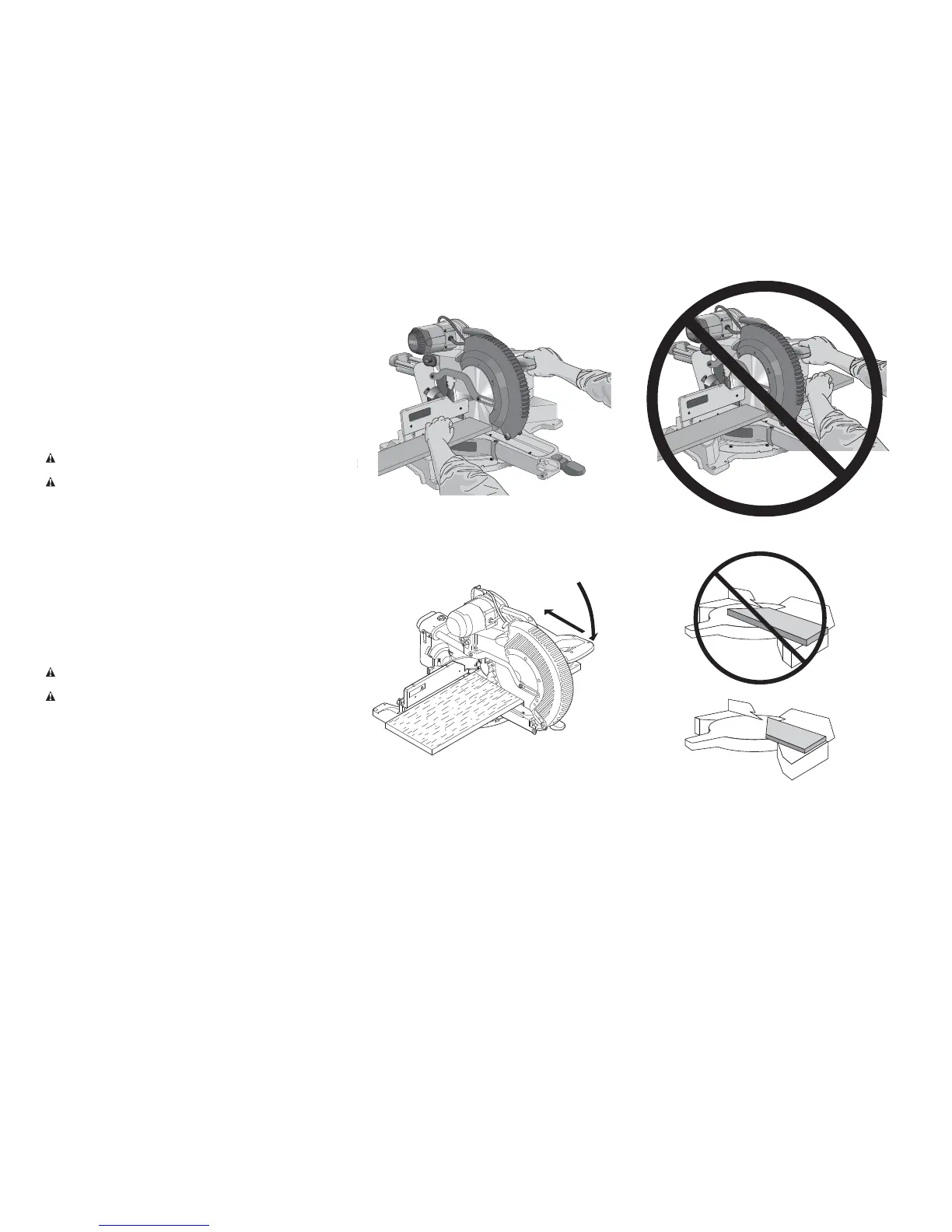88
• Do not attempt to cut excessively small pieces.
• Allow the blade to cut freely. Do not force.
• Allow the motor to reach full speed before cutting.
• Make sure all locking knobs and clamp handles are tight.
• Secure the workpiece.
• Although this saw will cut wood and many nonferrous materials,
these operating instructions refer to the cutting of wood only. The
same guidelines apply to the other materials. Do not cut ferrous (iron
and steel) materials, fibre cement or masonry with this saw!
• Make sure to use the kerf plate. Do not operate the machine if the
kerf slot is wider than 10 mm.
OPERATION
Instructions for Use
WARNING: Always observe the safety instructions and applicable
regulations.
WARNING: To reduce the risk of serious personal injury, turn off
the tool and disconnect it from the power source before attempting to
move it, change accessories or make any adjustments.
Refer to Saw Blades under Optional Accessories to select the blade that
best fits your needs.
Ensure the machine is placed to satisfy your ergonomic conditions in
terms of table height and stability. The machine site shall be chosen
so that the operator has a good overview and enough free surrounding
space around the machine that allows handling of the workpiece without
any restrictions.
To reduce effects of vibration make sure the environment temperature is
not too cold, the machine and accessories are well maintained and the
workpiece size is suitable for this machine.
Plug the saw into any household 60 Hz power source. Refer to the
nameplate for voltage. Be sure the cord will not interfere with your work.
Proper Body and Hand Position (fig. 17A, 17B)
WARNING: To reduce the risk of serious personal injury, ALWAYS use
proper hand position as shown in fig. 17A.
WARNING: To reduce the risk of serious personal injury, ALWAYS hold
securely in anticipation of a sudden reaction.
• Never place hands near cutting area. Place hands no closer than
152 mm (6") from the blade.
• Hold the workpiece tightly to the table and the fence when cutting.
Keep hands in position until the trigger has been released and the
blade has completely stopped.
• ALWAYS MAKE DRY RUNS (UNPOWERED) BEFORE FINISH CUTS
SO THAT YOU CAN CHECK THE PATH OF THE BLADE. DO NOT
CROSS HANDS, AS SHOWN IN Figure 17B.
• Keep both feet firmly on the floor and maintain proper balance. As
you move the mitre arm left and right, follow it and stand slightly to
the side of the saw blade.
• Sight through the guard louvers when following a pencil line.
Switching On and Off (fig. 1)
To turn the saw on, depress the trigger switch (X). To turn the tool off,
release the trigger switch.
Allow the blade to spin up to full operating speed before making the cut.
Release the trigger switch and allow the brake to stop the blade before
raising the saw head.
A hole is provided in the trigger switch for insertion of a padlock to lock
the saw off.
Use of XPS
TM
LED Worklight System (fig. 1)
NOTE: The mitre saw must be connected to a power source.
The XPS
TM
LED Worklight System is equipped with an on/off switch (Y).
The XPS
TM
LED Worklight System is independent of the mitre saw’s trigger
switch. The light does not need to be on in order to operate the saw.
To cut through an existing pencil line on a piece of wood:
1. Turn on the XPS
TM
system, then pull down on the operating handle
(C) to bring the saw blade close to the wood. The shadow of the
blade will appear on the wood.
2. Align the pencil line with the edge of the blade’s shadow. You may
have to adjust the mitre or bevel angles in order to match the pencil
line exactly.
Basic Saw Cuts (fig. 1, 18, 19)
If the slide feature is not used, ensure the saw head is pushed back as far
as possible and the rail lock knob (G) is tightened. This will prevent the
saw from sliding along its rails as the workpiece is engaged.
Cutting of multiple pieces is not recommended but can be done safely by
ensuring that each piece is held firmly against the table and fence.
STRAIGHT VERTICAL CROSSCUT
1. Set and lock the mitre arm at zero, and hold the wood firmly on the
table (Q) and against the fence (N).
2. With the rail lock knob (G) tightened, turn on the saw by squeezing
the trigger switch (X).
FIG. 17B
FIG. 19
FIG. 17A
FIG. 18

